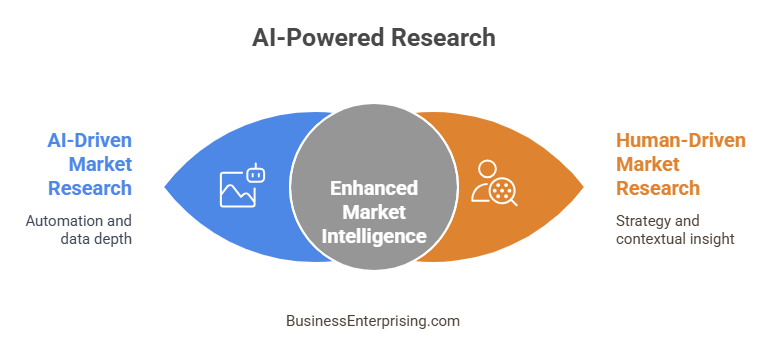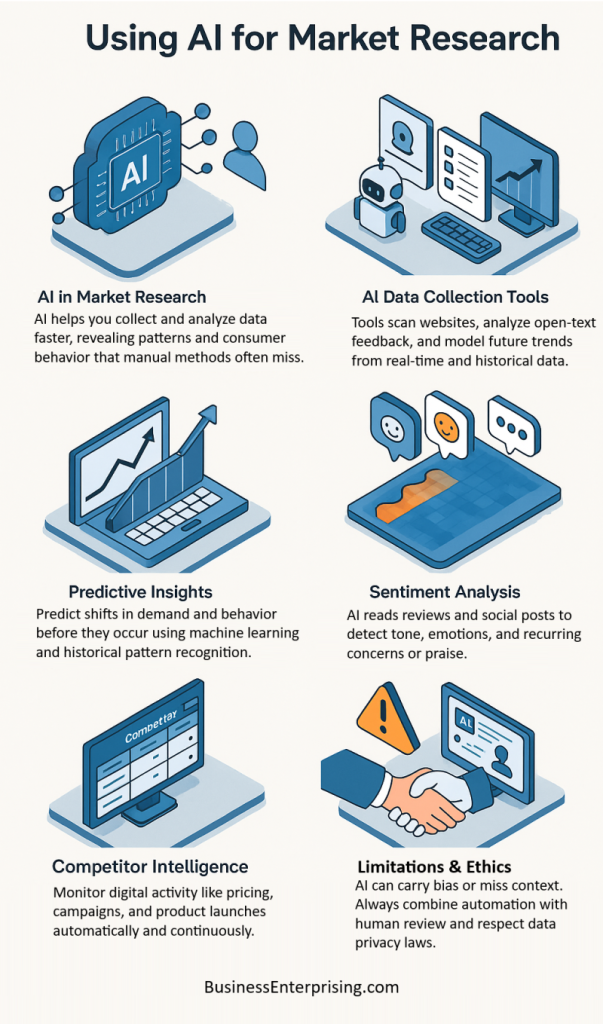 Market research helps you make smarter business decisions. However, traditional methods often take too long or miss key insights. That’s why many companies now prefer using AI for market research. It speeds up the process and adds new levels of depth. You get access to real-time data and patterns that were hard to detect before.
Market research helps you make smarter business decisions. However, traditional methods often take too long or miss key insights. That’s why many companies now prefer using AI for market research. It speeds up the process and adds new levels of depth. You get access to real-time data and patterns that were hard to detect before.
Additionally, AI tools reduce human error by automating routine tasks. They help you analyze reviews, track competitors, and predict trends. Therefore, your team can spend more time on planning and less on data entry. Also, the insights you gain are often more accurate and current. However, the shift to AI requires more than just new tools. It also demands a clear strategy for how you use them. Not every problem needs a complex model or algorithm. Sometimes, the simplest tools give the best results. That’s why your role in directing and interpreting the data still matters.
Furthermore, the market keeps changing. AI helps you keep up without getting overwhelmed. It filters massive amounts of information and shows you what really matters. This gives you a clearer picture and a faster path to action. When used well, AI helps you see what your customers want, what your competitors are doing, and where trends are heading. It turns raw data into useful insights. If you approach it thoughtfully, AI can make your research process stronger and more focused.
Introduction to AI in Market Research
Artificial intelligence is changing how companies approach market research. It helps you move faster, reduce human error, and cut costs. Traditional methods often rely on surveys, interviews, and historical reports. These techniques can be time-consuming and limited in scope. However, AI adds automation, scale, and pattern recognition to the process. It allows you to gather and process data in real time.
AI, in this context, refers to software that mimics human reasoning. It learns from data and makes predictions based on patterns. Rather than replacing human researchers, it assists them by handling repetitive tasks. Therefore, your team can focus on analysis and strategy. Additionally, AI can process large volumes of data that humans cannot manage alone. For example, AI tools can scan online reviews or social media posts instantly. They detect shifts in customer sentiment and surface emerging trends. This gives you a faster read on what your market wants. Furthermore, you gain insights that are often missed through manual review. Using AI for market research increases accuracy while saving time.
However, the true value of AI lies in its adaptability. It keeps learning and refining results as more data becomes available. That means your insights become stronger over time. Also, AI reduces guesswork by highlighting patterns early. As a result, you can make faster, more confident decisions.
AI does not eliminate the need for strategy or judgment. But it does improve how quickly and thoroughly you understand your market. When you combine AI with experience, your research becomes sharper and more reliable.
AI Tools and Technologies for Data Collection
AI tools now play a central role in collecting market data quickly and efficiently. These technologies gather both numbers and opinions. Web scraping bots, for example, scan online platforms to extract public data. They collect prices, reviews, search trends, and competitor details in real time. This process helps you monitor market shifts without manual work.
Additionally, natural language processing tools analyze open-ended responses. They interpret free-text feedback from surveys, chats, and forums. That means you can understand not just what people say, but how they feel. These tools detect patterns in tone, emotion, and context. As a result, you gain deeper insight into customer behavior.
Predictive modeling software also supports data collection by forecasting trends. It uses past behavior and current activity to suggest future outcomes. Therefore, your team can focus on likely scenarios rather than reacting to surprises. These models adapt as new data becomes available, which improves accuracy over time.
Using AI for market research allows you to combine structured and unstructured data at scale. Traditional research often separates quantitative and qualitative sources. However, AI brings them together into one framework. This helps you spot trends across channels that once operated in silos.
Furthermore, AI tools reduce human error during data entry and analysis. They standardize results and flag anomalies. That means your insights are more consistent and trustworthy. As you rely more on automated tools, your team has more time for interpretation and decision-making. AI doesn’t replace your strategy, but it does improve your access to quality data. When you use it wisely, you strengthen the foundation of your research.
Predictive Analytics and Trend Forecasting
Predictive analytics gives you a forward-looking view based on past activity. It uses AI to track patterns and forecast outcomes. This means you can spot demand changes before they fully develop. Rather than guess, you use data to anticipate your next move.
AI learns by analyzing large sets of historical data. It finds connections that humans might overlook. Therefore, it helps you understand why certain trends appear and how long they might last. Additionally, it updates those insights as new data comes in. That way, your forecasts stay relevant and accurate.
For example, AI models can predict which products may grow in popularity. They factor in variables like seasonality, pricing shifts, and customer behavior. As a result, you can adjust inventory, pricing, or marketing in real time. This approach helps you react faster and with less risk.
Using AI for market research gives you the advantage of speed and precision. Traditional methods rely on fixed reports or manual analysis. However, AI adjusts constantly to reflect fresh inputs. That flexibility helps you keep pace with shifting demand.
Furthermore, these models reduce noise by filtering irrelevant data. They highlight what matters most to your decision-making. You no longer need to sort through hundreds of reports manually. Instead, you focus only on the trends that impact your goals.
AI can’t guarantee perfect predictions, but it improves your odds. When you pair machine learning with your own insight, your strategy becomes sharper. It’s not about replacing judgment, but about making smarter calls with better data.
Sentiment Analysis and Consumer Behavior Insights
AI-powered sentiment analysis helps you understand how people feel about your brand, products, or services. It reviews large volumes of content quickly. These tools scan online reviews, forum posts, and social media updates to detect tone and intent. They identify emotions behind the words so you can measure reactions more accurately.
Rather than relying only on survey data, you gain insights from organic conversations. This gives you access to honest feedback in real time. Additionally, sentiment analysis breaks down positive, neutral, and negative responses. That means you see how people truly feel, not just what they say.
These tools use natural language processing to interpret meaning. For example, they can detect sarcasm, frustration, or satisfaction in customer reviews. Therefore, you get more than just keywords—you get context. Also, they highlight repeated themes, such as pricing concerns or product satisfaction. That helps you understand customer priorities and behavior.
Using AI for market research makes your analysis more dynamic and less biased. Traditional methods often miss emotional patterns or subtle shifts in perception. However, AI keeps scanning continuously and adapts as conversations evolve. This helps you stay ahead of changes in public opinion.
Furthermore, AI helps you target the right customer groups. It tells you who is talking, what they care about, and why they respond a certain way. With this data, you can adjust messaging or product features based on real concerns. When you combine human insight with AI tools, your market understanding improves. You learn not just what your audience says, but what drives their choices.
Competitor Intelligence through AI Automation
AI automation helps you track your competitors with more speed and precision. These tools monitor public digital activity across websites and platforms. They scan changes in pricing, promotions, and customer reviews without needing manual checks. As a result, you get a clear view of your competitors’ behavior.
Additionally, AI tracks product launches and marketing efforts in real time. It alerts you when a competitor updates their catalog or starts a new ad campaign. This gives you a chance to respond faster and stay informed. Therefore, you avoid falling behind or missing key developments.
These tools also analyze ad performance by observing frequency, keywords, and traffic volume. That helps you understand which tactics are gaining attention. You can then apply or refine those ideas in your own strategy. However, the goal is not just to copy but to adapt insights into smarter planning.
Using AI for market research means turning raw competitor data into useful action. The software filters out noise and highlights patterns that matter. You gain a more focused view of the market without sorting through clutter. Furthermore, the insights update regularly, giving you an ongoing advantage.
AI doesn’t just collect data. It organizes it into trends, timelines, and visual summaries. That helps your team make informed decisions faster. Also, it reduces time spent on manual competitor research.
When you understand your competition better, you improve your own performance. AI helps you act based on facts, not assumptions. That makes your marketing, pricing, and product strategies more responsive and effective.
Limitations and Ethical Considerations
AI has clear benefits, but it also comes with limitations you should not ignore. One concern is algorithmic bias in decision-making. If the training data contains bias, the AI will reflect it. Therefore, you may receive results that favor one group unfairly. This can lead to flawed insights and missed opportunities.
Additionally, using AI for market research raises questions about data privacy. Many tools gather data from public and semi-public sources. However, not all users consent to their data being analyzed. That creates legal and ethical challenges, especially if you operate across multiple regions. You must remain aware of privacy laws and adjust your practices accordingly.
AI also lacks human judgment and context. While it can process large datasets, it doesn’t fully understand nuance or intent. For example, sarcasm or cultural references may confuse it. Therefore, your team must review and interpret AI findings with care. Also, you should double-check recommendations before acting on them.
Moreover, AI can create a false sense of certainty. Just because results are data-driven doesn’t make them accurate. Additionally, over-reliance on AI may reduce critical thinking. You need to keep asking questions and verifying assumptions.
AI works best when paired with human insight. Use the data as a guide, not a final answer. When you combine tools with your own expertise, your results improve. That balance matters more as AI becomes more widely used. Using AI for market research is effective, but you still carry responsibility. Ethical use starts with awareness and ends with thoughtful decision-making.
Conclusion
AI brings more speed, depth, and accuracy to the way you collect and interpret market data. It supports smarter business decisions. However, the real value comes when you combine AI tools with human judgment. That mix gives you a clear edge. Additionally, AI helps you respond to changes faster. You no longer have to wait for quarterly reports or surveys. Instead, you get updates in real time. Therefore, you can adjust your strategies while others are still reacting.
Using AI for market research gives you insights you might miss through manual methods. It highlights trends, emotions, and competitor actions. Also, it saves you time by automating repetitive tasks. That frees up your team to focus on creative and strategic work.
However, no system is perfect. You still need to ask questions and review results with care. Bias, errors, and missing context can all affect your analysis. That’s why your input remains essential at every stage. Furthermore, data privacy laws are always evolving. You must stay informed and respect user rights. Responsible use builds trust and protects your business long term.
AI should support your goals, not drive them alone. Use it as a tool, not a crutch. When applied thoughtfully, it gives you better information and clearer direction. As more businesses adopt these tools, competitive gaps will grow. Those who act early tend to learn faster and improve quicker. If you apply the right balance, you will get more out of your research efforts.



